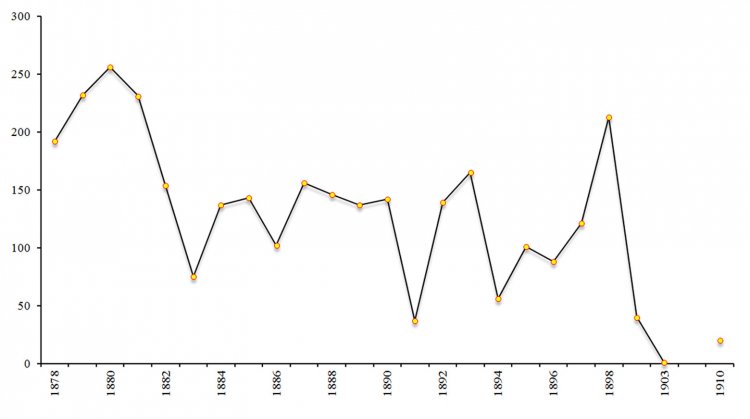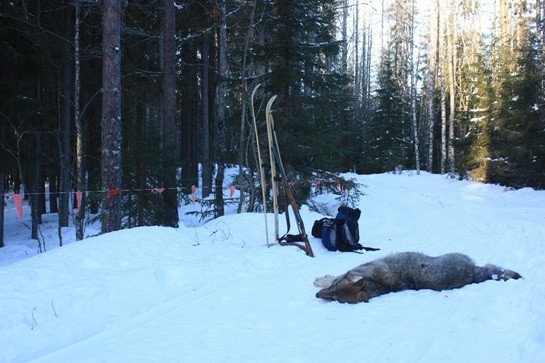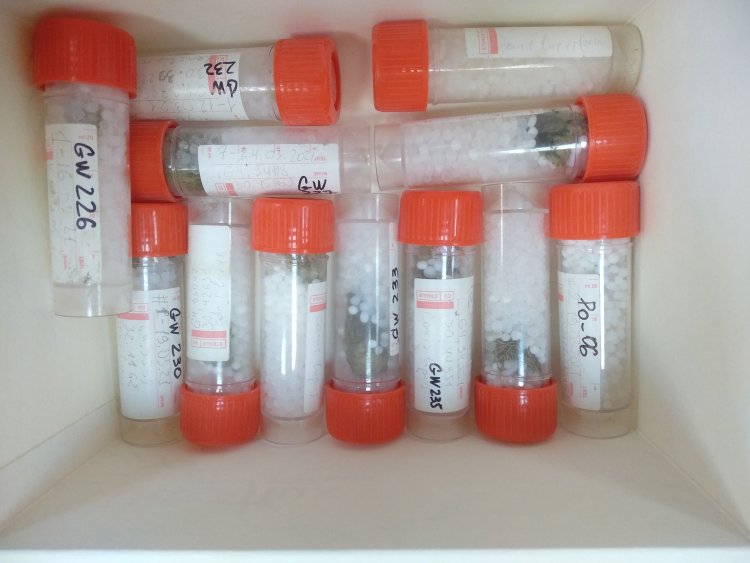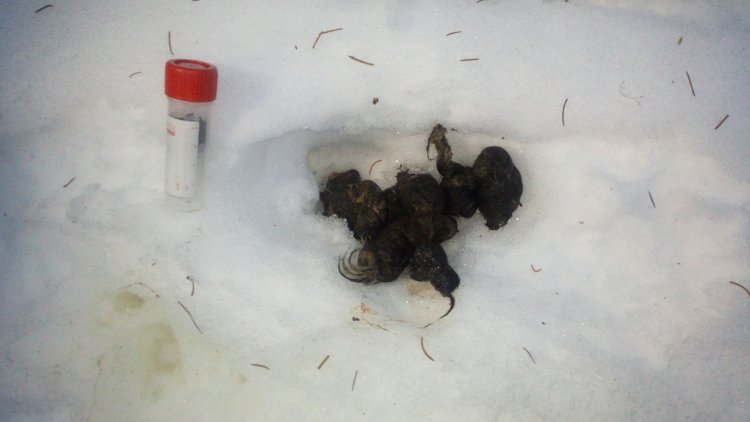Karelian biologists are conducting comprehensive studies of the wolf population in the North of Russia: these large predatory mammals play an important role in food chains and the regulation of the number of other species
The wolf – a legendary mythological and folklore image symbolizing hunting prowess, endurance, courage – is well known as an ecologically plastic species of predatory mammals adapted to living in different latitudes and climatic zones. The wolf population dynamics and its vital activity are directly related to the abundance of forage objects (mainly wild ungulates), this relationship is formed as finely tuned mechanisms of the predator-prey system. However, there are not so many places left untouched by the ubiquitous human activity on our planet. In most countries to varying degrees harnessed by agriculture, the wolf largely exists only due to the numerous livestock and various domestic animals. In this regard, control over the number of wolves is required, the growth of wolves’ head count can become a threat to agriculture and the population. To this end, a scientifically based collection of information on ecological and population characteristics and the ecological role of the wolf in biological communities is necessary.
A team of scientists from the Karelian Research Center of RAS in Petrozavodsk is working to study the state of wolf populations. Specialists collect monitoring information (distribution, abundance, production, some biological indicators) and consider the current place and role of wolves in biocenoses (relationships with other wild animals) depending on the landscape and climatic features of the territory and the human persecution factor. Biologists note, systematize, and analyze many features of the predators’ ecology. Particular attention is paid to the predation of wolves against dogs, possible causes of the appearance of wolf-dog hybrids are identified.
Konstantin Feliksovich Tirronen – Candidate of Biological Sciences, head of the Laboratory of Zoology at the Institute of Biology of the KarRC RAS (Petrozavodsk) – spoke about a unique strong animal that certainly causes an intuitive sense of anxiety and danger in humans – the wolf, and about the relationship of this large predatory mammal in the predator-prey chain at different phases of population dynamics in the European North of Russia, as well as about how modern population studies of the species are conducted.
In many sociocultural traditions of different peoples, the wolf acts in a significant way, personifying fearlessness and freedom, although since ancient times it has always been in a competitive relationship with a person for resources and was dangerous. What unique features or facts about the wolf (maybe not coinciding with generally accepted ideas) attracted you and what determines your interest as a biologist in studying the wolf ecology in the European North of Russia?
“Indeed, the wolf is an animal with amazing charisma, even among large predators; however, as you correctly noted, this does not explain our interest in studying wolves. The European North of Russia is home to the so-called big four large predatory mammals – wolverine, brown bear, lynx, and, of course, wolf. This representative of the Canidae family is an important, integral component of our northern ecosystems, the balance in which is largely determined by its activities. At the same time, of course, the incredible adaptability of this species, which skillfully survives in the conditions of almost incessant and even increasing human pressure, is also admired. And here it must be said that we do not know everything about the specific mechanisms of the species plasticity or the role of the wolf in anthropogenically transformed communities,” Konstantin Tirronen said.
Wolves from the Karelo-Finnish population group.
What place does the wolf occupy in the northern forest biocenoses and ecosystems today?
“As you understand, the wolf is a predator, and this role for it is predetermined by evolution. This beast will not eat cabbage. Large carnivorous animals occupy the top positions in food pyramids, and their role, as it was shown in the works of domestic and foreign zoologists and ecologists, is usually regulatory. The system of “predator-prey,” or rather “wolf-ungulates,” has developed over millennia in our North. Practically the only element that introduces dissonance into well-functioning natural systems is the human, and all other elements have to adapt to the presence and active intervention of humans,” the Karelian researcher clarified.
How many individuals are currently living here?
“We can judge about the number of wolves in a particular region only approximately, and by no means from the fact that they are difficult to count, although it is relevant too. The fact is that wolves, as well as other animals, do not recognize administrative and even state borders at all and move freely between regions. Only serious geographical obstacles and, of course, people with their megacities, large-scale linear infrastructure facilities, etc. can stop or reduce the intensity of movements. However, you want to hear a specific figure, so, in Karelia, the average long-term number of wolves is about 400 individuals, but here I also must make a reservation. It all depends on what period of the year we will look at the wolf population. In spring, wolves bring offspring, and their total number increases greatly, but not all young animals survive until fall (for natural reasons), and then the hunting season begins, and by the end of winter the wolf tribe is greatly thinning. Such interannual fluctuations in our population can reach 200 individuals,” the scientist pointed out.
What are the regional ecology specifics of the wolf living in Karelia?
“There are no regional, ‘Karelian’ specifics of the wolf’s ecology. It is important to note here that all natural systems are characterized by one constant feature – dynamism. They develop over time, factors act with different intensity: some arise, others leave the arena. In this regard, it is extremely important for us to continuously monitor these changes, and the wolf in this sense is a fertile object of observation. It easily adapts to changes, can switch from one type of prey to another, uses anthropogenic food sources, and in case of a critical threat to the population, it can enter into interspecific hybridization with a dog,” Konstantin Tirronen noted.
In the European North of Russia (in Karelia), do wolves lead a more solitary lifestyle or do they more often get together in a large pack?
“Neither. It is worth starting with the fact that the conditions, the environment form and determine the population, and in this case the family structure of the species. It is known that in some regions, in the open spaces of the Arctic latitudes, wolves often form large packs to hunt large and, as a rule, herd animals. It’s easier that way. Life itself dictates the rules. In our country, packs of wolves usually consist of a breeding alpha pair, offspring of this year, 1–3 one-year-olds, and 1–2 individuals of other age groups. But the composition and number of packs strongly depend on the abundance of the main victims, the wolf population density, and the intensity of human persecution. A characteristic feature for the north of Karelia is a rather significant separation of wolf packs from each other, which is determined by the characteristics of the northern taiga biocenoses. Classically, the predator’s population dynamics follows changes in the victim’s population with a lag of one or two years, but wherever new limiting factors appear in the system, everything changes,” the scientist explained.
What is the relationship between wolves and potential victims and what is the reverse reaction of predators to changes in prey populations?
“For example, in Karelia for decades there had been a clear dependence of the wolf population dynamics on the moose – its main prey (see Fig. 1). In the last decade, the curves of the number of these species diverged: amid the growth in the number of moose, there was a drop in the wolf population, which was associated with the intensification of hunting for the latter. However, as soon as people stop actively hunting wolves, the dynamics of changes in parameters re-enters its natural course,” the researcher clarified.
Figure 1. Dynamics of the number of moose (red) and wolves (black) in Karelia
Recently, some regions of the country record attacks by wolves not just on livestock, but on dogs. How can this be explained? Is it only a lack of food, or are there any disturbances in the forest ecosystem (maybe the conquest of territory)? What does the appearance of wild animals in populated areas generally indicate?
“There is nothing new in this problem, quite the opposite. In a normal situation, wolves consider dogs prey and do not have any warm feelings for their fellows. We brought up archival records of wolf attacks on livestock and domestic animals. And I must say that in the historical past of the Russian state, such records were kept much better than now. So, in some years, up to 250 dogs were killed by wolves in the Olonets Governorate alone annually (see Figure 2). According to our data, today this sad figure reaches 150 dogs in Karelia. At the same time, the structure of attacks is clearly traced. The first peak of attacks is recorded in fall when adult wolves begin to take the young to hunt and hone their skills on dogs. At the same time, in the past, in the 1960s – 1970s, this variable was fairly supplemented by hunting dogs, since the hunting season opens in autumn. Now there are much fewer such cases, not because wolves have become more loyal to working hunting dogs, but simply there are much fewer hunting dogs. Although they still fall in the teeth of gray predators. The second surge of attacks is registered in January-February, which is due to the deep snow and lack of crust snow, and this circumstance makes it very difficult for wolves to chase high-legged elks and forces them to pull up to human habitation again,” Konstantin Tirronen explained.
Figure 2. Wolf attacks on dogs in the Olonets Governorate.
The graph shows the number of dogs killed by wolves and mentioned in the Olonets archives.
Have you ever met wolves in the forest and confronted them? Did anything surprise you or was the wolf’s behavior predictable?
“To me, the most memorable and revealing episode, in this sense, was a seemingly unremarkable case from my student years. When in August, during our practical training, my partner and I spent a night in the forest and, lying on fir branches under a soldier’s blanket, already falling asleep, we heard a wolf howling very close by. We had no weapons, but we knew perfectly well that the wolves didn’t care about us. Nevertheless, our hands instinctively reached for knives and an ax. This perfectly illustrates how deep, literally at the genetic level, the fear of this beast sits in us,” the scientist shared his impression.
Is it true that the wolf is very much afraid of the human, and if it is not provoked, it will go away? Or is it always a huge risk for a human? How should you behave correctly in the forest when you unexpectedly meet a wolf?
“Of course, the wolf is fearful of people. Attacks happen from rabid animals, but this has not been registered in Karelia. In addition, the so-called synanthropic wolves, which are already accustomed to living next to people and eating at their expense, can pose a danger. It is believed that hybrids with a dog are more courageous towards humans, this also happens. In addition, a sick, weakened, or old animal can attack, often already standing on the edge of its death. Although, there is no doubt that the danger from a wolf is nothing compared to the danger to humans from another predatory animal – the bear,” explained Konstantin Tirronen.
What new data on the genetic structure of the Karelian wolf population have you obtained? How will this information help identify the role of wolves in biocenosis and their spread to other regions?
“Recently, it has become possible to add new methods to the traditional methods of studying animals, and genetic approaches occupy an important place among them. To the extent possible, we conduct such research both independently and as part of various scientific collaborations, including international ones. For more than 10 years, we have been collecting biological material from wolves hunted by hunters (see photo On the Hunt).
Wolf hunted with flagging – a traditional Karelian strategy
This material’s analysis provides a unique opportunity to judge the state, structure, and changes in the populations of wolves inhabiting our region, by which, first of all, I mean Eastern Fennoscandia. I did not make a reservation here, since wolves inhabiting Karelia, Finland, the southern and western parts of Murmansk Oblast, Arkhangelsk Oblast can be combined into a single population continuing further south and east, in which there is a more or less intensive flow of genes, the process of genetic material exchange takes place. But the wolves living in Sweden are practically isolated. However, returning to our “Karelian” wolves, I would like to note several interesting features of the grouping we studied. For the entire rather long period of collecting the data, only one animal from the entire sampling (more than 100 samples) turned out to be a hybrid with a dog of the first or second generation. This suggests that reproduction in our wolves goes naturally according to the laws of nature. The appearance of this hybrid may even be the result of the deliberate crossing of a wolf and a dog by a person: alas, this also sometimes happens. In general, we can say that the genetic diversity of wolves in the region is quite high, and the population is characterized by a fairly high level of panmixia, i.e., random mating. However, it is obvious that the family structure of the animals studied by us differs from classical representations. As a result of intensive hunting of wolves in packs, a premature change of partners of a breeding pair occurs, which is clearly traced by the results of our genetic studies. This is how our animals differ from the wolves that live in places where they are not hunted, and the pack core – the breeding pair – survives for a long period,” the researcher informed in detail.
As Konstantin Tirronen notes, “today, noninvasive (noncontact) methods of obtaining biological material from animals have become very popular and important – these are fur, various animal secretions (see photo below).
Sealed containers filled with silica gel with animal excrement samples for further genetic analysis.
Such material is of particular value and allows us to judge the role of animals currently living in the population, and not removed from it. Additionally, within the framework of international cooperation, it is possible to obtain unique results. We took part in such a large-scale study with scientists from Sweden, Finland, Denmark, and Norway (the work results are published in the article SMEDS L., ASPI J., BERGLUND J., KOJOLA I., TIRRONEN K., ELLEGREN H. WHOLE-GENOME ANALYSES SHOW LIMITED SIGNS OF DOG INTROGRESSION IN THE FENNOSCANDIAN WOLF POPULATIONS // EVOLUTIONARY APPLICATIONS. 2021. 14:721–734.). The work performed was based on a genome-wide analysis of DNA sequences of more than 200 wolves from Scandinavia, Finland, and Russia (Karelia), selected over many years. These data were compared with a large number of dogs of different breeds, as well as with wolves from other parts of the world. The study aimed to assess the presence of signs of mixing of Fennoscandian (Scandinavia, Finland, and Karelia) wolves and dogs, as well as to consider the genetic relationship between the wolves of Fennoscandia. The analysis showed that dogs and wolves were clearly separated from each other, with three hybrids of the first generation located exactly between the clusters of dogs and wolves (see Fig. 3).
Figure. 3. PCA of wolves and dogs based on whole-genome sequence data. (a) All Scandinavian, Finnish and Russian Karelian wolves, three F1 hybrids and 112 dog genotypes. (b–c) Same PCA as in 1a, but showing the effect of drift and inbreeding in Scandinavian wolves. The rest of the samples are shown in grey for better visibility. (b) Scandinavian-born wolves colored based on the number of generations to the closest founder. (c) Scandinavian-born wolves colored based on inbreeding.
In general, the level of admixture in Fennoscandian wolves seems to be lower than in other European populations. Wolves of Scandinavian origin (Sweden) separated from Finnish and Karelian wolves, and the latter two groups were inseparable. The inbred ‘Swedish’ population (i.e., with a high level of closely related mating), practically isolated from Finnish-Karelian wolves, nevertheless traces its ancestry from the once common population that inhabited the Scandinavian peninsula, Finland, and the north-west of Russia.”
“Here I want to mention and thank our colleagues with whom we have been conducting long-standing joint and fruitful work: this is a group at the University of Tartu under the leadership of Urmas Saarma, the group of Jouni Aspi from Oulu, the team of Hans Ellegren from Uppsala University, and many others,” Konstantin Tirronen emphasized.
What is the current strategy of wolf protection in Karelia? What are the problems associated with the preservation or, conversely, the limitation of the number of this species?
“No, there is no wolf protection to talk about. On the contrary, as I have already noted, gray predators are actively hunted here. More than 100 individuals are hunted annually in Karelia. Today, environmental and animal protection sentiments are extremely widespread, and this is good, in my opinion. But I also can’t help but note that in many ways only thanks to hunters, large predators, in particular the bear and the wolf, form fear of man. And this is very important in an environment that has already been transformed by man in one way or another and where we live side by side with these animals. I want to be asked as little as possible: what to do when meeting a bear or a wolf, or what to do when it attacks you? Exactly because of the fear of humans, predators will try to avoid meeting us by all means,” the scientist noted.
What methods of animal monitoring are practiced?
“Of the monitoring programs for wolves, we only implement the so-called Winter Route Count, the quality of which decreases from year to year. As for the management of wild animal populations, it should be based on the principles developed during in-depth scientific research and, moreover, be of an interregional nature. Just as we divide animal populations between regions and countries, we must also share responsibility for their management and further well-being. It is necessary to be guided by the principles of responsible environmental management. To date, alas, we have not come close to such formulations. Unfortunately, in our country, the state structures responsible for the management, exploitation, and conservation of natural resources are not interested in the implementation of scientific research and development in this area, as well as in the active involvement of citizens in these processes. All this is in sharp contrast to the situation in our neighboring countries, I mean Scandinavia and Finland,” the Karelian researcher stated.
Currently, the KarRC RAS together with the Swedish-Karelian Business and Information Center, on the initiative and with the support of Swedish partners, has launched the project Wolf: Barents Predators – Managing Large Carnivores in Barents Region, within which it is planned to organize a network of cooperation of different-level specialists to implement unified protocols for monitoring the species in the territories of the Fennoscandia countries and develop common principles for managing predator populations.
As Konstantin Tirronen noted, “today, some planned fieldwork has been carried out within the project framework. So, in March 2021, the technique of noninvasive biomaterial collection was worked out on the territories of the Kalevalsky Municipal District and the Kalevalsky National Park in Karelia, and an expedition to the Kola Peninsula took place (see Fig. 4).
Figure 4. Noninvasive collection of biomaterials.
“The method of biomaterial collecting involves collecting animal excrements in containers with granular silica gel (see Fig. 5). Then the samples are stored frozen in the freezer. In June, we worked in the central and eastern part of the Kola Peninsula, where the most poorly studied group of wolves in our entire region lives. In general, I must say that our fieldwork takes place in different, sometimes amazing, hard-to-reach, and sometimes the most ordinary corners of the region: it can be very remote tundra of the Kola Peninsula or just the outskirts of settlements. It all depends on which animals are in the focus of research and where they can be found at this time.”
Figure 5. Collection of samples in containers with granular silica gel.
So, diverse studies of Eastern Fennoscandia wolves, conducted by specialists of KarRC RAS, contribute to the identification of new species-related specifics of the predator, including the species genetic structure, as well as understanding of the functioning of natural and transformed ecosystems, of which the wolf is an integral element.
*All images are provided by Konstantin Tirronen





























